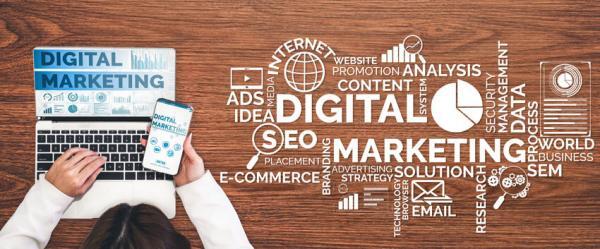The business world is rapidly changing, and digital marketing has become an essential part of any successful marketing campaign. The rise of social media, mobile devices, and search engines has made it easier for businesses to reach potential customers. However, attracting new business requires more than just having a website or social media presence. A proactive digital marketing campaign is essential to ensure that businesses reach their target audience and stand out from the competition. In this article, we will discuss the steps businesses can take to create a proactive digital marketing campaign that attracts new business.

Step 1: Define Your Target Audience
The first step in creating a proactive digital marketing campaign is to define your target audience. Who are the people that you want to reach? What are their interests, values, and pain points? By understanding your target audience, you can create content that resonates with them and speaks directly to their needs.
There are many ways to define your target audience, including:
>>> Conducting market research
>>> Analysing your existing customer base
>>> Creating buyer personas
Market research involves gathering information about your industry, competitors, and potential customers. This can be done through surveys, focus groups, and online research. Analysing your existing customer base can also provide valuable insights into the demographics, interests, and behaviours of your target audience. Finally, creating buyer personas involves creating fictional characters that represent your ideal customer. This can help you better understand their needs, motivations, and pain points.
Step 2: Develop a Strong Brand Identity
The next step in creating a proactive digital marketing campaign is to develop a strong brand identity. A strong brand identity helps businesses stand out from the competition and build trust with potential customers. Your brand identity should be consistent across all channels, including your website, social media, and advertising.
To develop a strong brand identity, businesses should consider the following:
>>> Defining your brand voice and tone
>>> Creating a brand style guide
>>> Developing a unique visual identity
Your brand voice and tone should reflect your company’s personality and values. This can be formal, informal, humorous, or serious, depending on your target audience and industry. Creating a brand style guide can help ensure consistency in your branding, including your logo, colours, typography, and imagery. Developing a unique visual identity can also help your brand stand out and create a memorable impression with potential customers.
Step 3: Create Engaging Content
Creating engaging content is essential to attract new business and build brand awareness. Content can take many forms, including blog posts, videos, social media posts, and email marketing campaigns. To create engaging content, businesses should consider the following:
>>> Creating content that addresses your target audience’s pain points
>>> Using a variety of content formats
>>> Incorporating visual elements, such as images and videos
Creating content that addresses your target audience’s pain points is essential to attract their attention and provide value. Using a variety of content formats can also help keep your content fresh and engaging. Finally, incorporating visual elements can help make your content more engaging and memorable.
Step 4: Optimise Your Website for Search Engines
Search engine optimisation (SEO) is the process of optimising your website to rank higher in search engine results pages (SERPs). Optimising your website for SEO is essential to attract new business and increase your online visibility. To optimise your website for SEO, businesses should consider the following:
>>> Conducting keyword research
>>> Creating high-quality content
>>> Optimising your website’s structure and navigation
Keyword research involves identifying the keywords and phrases that potential customers are searching for related to your products or services. Creating high-quality content that incorporates these keywords can help improve your website’s ranking in SERPs. Optimising your website’s structure and navigation can also help search engines better.
Step 5: Utilise Social Media
Social media is a powerful tool for businesses to reach their target audience and promote their brand. There are many social media platforms available, including Facebook, Twitter, Instagram, and LinkedIn. To effectively utilise social media, businesses should consider the following:
>>> Choosing the right social media platforms for their target audience
>>> Creating a social media content calendar
>>> Engaging with their audience through comments and messages
Choosing the right social media platforms for your target audience is essential to ensure that your content reaches the right people. Creating a social media content calendar can help you plan and schedule your content in advance, ensuring that you post consistently and effectively. Engaging with your audience through comments and messages can also help build relationships and trust with potential customers.
Step 6: Run Paid Advertising Campaigns
Paid advertising campaigns, such as pay-per-click (PPC) advertising, can be an effective way to reach potential customers and increase website traffic. To run successful paid advertising campaigns, businesses should consider the following:
>>> Choosing the right platform and ad format
>>> Targeting the right audience
>>> Creating compelling ad copy and visuals
Choosing the right platform and ad format depends on your target audience and marketing goals. For example, Facebook ads may be more effective for B2C businesses, while LinkedIn ads may be more effective for B2B businesses. Targeting the right audience is essential to ensure that your ads reach the right people. Creating compelling ad copy and visuals can help increase click-through rates and conversions.
Step 7: Measure and Analyse Results
Measuring and analysing the results of your digital marketing campaign is essential to understand what’s working and what’s not. To effectively measure and analyse your results, businesses should consider the following:
>>> Setting clear goals and KPIs (key performance indicators)
>>> Using analytics tools to track website traffic and engagement
>>> Analysing the data and adjusting the campaign accordingly
Setting clear goals and KPIs can help you track the success of your campaign and make data-driven decisions. Using analytics tools, such as Google Analytics, can help you track website traffic, engagement, and conversions. Analysing the data and adjusting the campaign accordingly can help you optimise your digital marketing strategy and achieve better results.
The Way Ahead
A proactive digital marketing campaign is essential for businesses to attract new customers and build their brand. By defining your target audience, developing a strong brand identity, creating engaging content, optimising your website for search engines, utilising social media, running paid advertising campaigns, and measuring and analysing your results, businesses can create a successful digital marketing campaign that drives results.
It’s important to remember that digital marketing is an ongoing process, and businesses should continue to monitor and adjust their strategy to stay ahead of the competition and reach their marketing goals.





